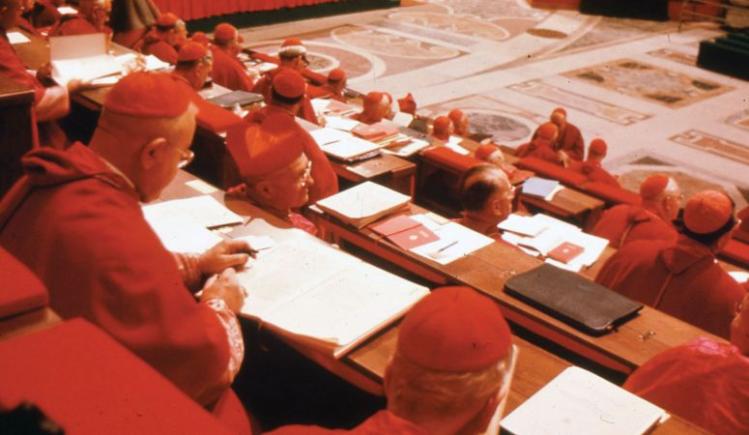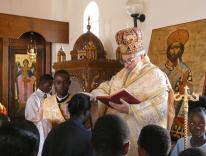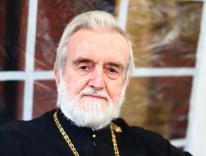
Last October marked the fiftieth anniversary of Nostra aetate (“In Our Time”), the Second Vatican Council’s Declaration on the Relation of the Church to Non-Christian Religions. Commonweal has devoted a great deal of space over the years to explaining and exploring the significance of Nostra aetate for Catholic-Jewish relations. Luke Timothy Johnson, Donald Senior, John Connelly, Steven Englund, Philip A. Cunningham, and John R. Donahue are just a few of the scholars who have analyzed various facets of the document in these pages. One aspect of the declaration that perhaps deserves greater attention is the impact it made on Protestantism at the time, an impact that can shed light not only on Christian-Jewish dialogue but also on fundamental questions about the nature of revelation dividing Catholics and Protestants.
Many Protestant theologians of 1960s viewed Vatican II as a whole in overwhelmingly positive terms, as a transformative divine event with implications not only for Rome but for the whole Christian Church; even the neo-orthodox theologian Karl Barth—arguably the most influential Protestant theologian of the twentieth century—praised much of the council’s work. When it came to Nostra aetate, however, Protestant commentators weren’t so sure. Barth was disturbed by aspects of the declaration, and Protestant theologians in Europe and the United States, following his lead, tried to dodge it. Indeed, for the first twenty years after the council, no official Protestant church statement explicitly mentioned it.
Why did a text so significant to the history of Catholicism get such a muted reception in Protestant thought and practice? Answering this question means reviewing how Nostra aetate was assessed both by Barth and by the Protestant theologians serving as ecumenical observers in Rome between 1962 and 1965. For already in their early comments we find the concerns that would define the Protestant engagement with the text—or lack thereof—for years to come.
These early Protestant commentaries disclose two very different modes of reaction to Nostra aetate. The first takes up those passages that revoke the traditional anti-Judaic theology of the Christian Church. Here Nostra aetate and the powerful Barth school complemented each other, both recognizing the role of the Jewish people as distinct partners in God’s salvific plan for the world, and embracing a corresponding theological overhaul of Jewish-Christian relations. In touting the “spiritual bond” between Christians and Jews, rebuffing the idea that Jews had been rejected by God, and even invoking St. Paul’s image of the olive tree whose old root supported younger branches, the Catholic Church had finally acknowledged her primal connection to her older Jewish sibling. Protestant theologians greatly welcomed this new recognition of Israel’s meaning for the church, viewing it as one of the groundbreaking insights of the council; some expressed the hope that it would inspire a new theology of Israel in the World Council of Churches.
Protestant contemporaries also embraced Nostra aetate’s rejection of anti-Semitism—and discussed its omission of a confession of guilt for the persecution of Jews by the Christian church. The World Council of Churches had yet to produce such a statement for sins committed against the Jewish people, but the issue resonated with many ecumenically minded Protestants, not a few of whom believed that a new Jewish-Christian beginning depended on such a confession. Stanley Stuber and Claud Nelson’s 1967 Baptist/Methodist coproduction, Implementing Vatican II in Your Community, criticized the declaration for omitting such a confession. “For centuries Christians have put Jews on the cross, [and now] some degree of Christian repentance is required,” wrote Stuber and Nelson, who had both been in Rome throughout the council. Barth, too, echoed the deep longing for an official Christian admission of guilt. “Would it not be more appropriate, in view of the anti-Semitism of the ancient, the medieval, and to a large degree modern church,” he wrote, “to set forth an explicit confession of guilt here?”
Beyond the Jewish-Christian relationship, however, many leading Protestants rejected Nostra aetate’s dialogical engagement with non-biblical religions. That dialogue rested on the traditional Catholic natural-theology approach, which argued that reason, as well as revelation, discloses God’s existence. If all men are endowed with reason and the desire for religion, as natural theology presupposed, non-Christians could indeed participate in the divine truth revealed in Christ. As a result, Nostra aetate mentioned Buddhism, Hinduism, and Islam as well as Judaism. Citing John 14:6, it maintained that all of these religions reflected aspects of God’s unique truth in Christ, asserting that those traditions often “reflect a ray of that Truth which enlightens all men.”
Protestants of the Barthian inclination, however, viewed natural theology’s elevation of reason as a trap for making God in our own image. Like Barth, and under the influence of his theology, most of the Protestant theologians attending the council as observers were unable to accept non-Judeo-Christian religions as divinely ordained, and made a categorical distinction between human religious practices on one side and God’s revelation in Christ and Israel on the other. They could not see the “ray of truth” in other religions that the declaration spoke of and that many Catholics began to explore after the council.
THESE TWO MODES OF engagement hint at the contested history of the declaration itself. Nostra aetate went through many drafts. First planned as a separate statement on the Jewish people, it was later considered for placement in the “Decree on Ecumenism.” Afterwards it was reworked accordingly, the parts concerning Jewish-Christian relations now fused with a statement on non-Christian religions. Many Barthian Protestants openly took issue with this fusion. For instance, New Testament scholar Oscar Cullmann, a colleague of Barth’s at the University of Basel and one of the most influential Protestant observers at the council, complained that Nostra aetate made Judaism appear to be like any other religion, and hence failed to recognize the particular and ongoing role of the biblical Israel and the Jewish people in the events of salvation. While he and other leading Protestants embraced those sections of Nostra aetate that firmly connected Christians and Jews by a mutual history of salvation, they believed that this history excluded all non-biblical religions. Thus Lukas Vischer, a Swiss Reformed theologian who had been one of the World Council of Churches’ observers at the council, commented with dismay that “God’s Chosen People is thus drawn into the context of the ‘religions.’” To Barthian theologians like him, the biblical Israel did not present a mere “religion,” but the original and sole form of God’s revelation, and Vischer openly doubted that “the revelation of the God of Abraham, Isaac, and Jacob can be correctly understood in this context [of religions]” at all.
Clearly, then, on this new interreligious turf laid down by Nostra aetate, the Catholic faithful walked two steps ahead of their Protestant brethren. A few early Protestant commentators, however—notably the Americans, who had returned to a much more religiously diverse society than most of their European counterparts—sensed that the Catholic bishops were on to something. William Norgren, an Episcopal priest from New York and executive director of the Faith and Order Commission of the National Council of Churches, affirmed that the declaration was the “first official statement of the Roman Church ever [that] appreciated the values in other religions.” William Barnett Blakemore, a minister in the Christian Church (Disciples of Christ) and professor at the Divinity School of the University of Chicago, noted that “Catholicism is more open to discussion with ‘the world’ at large than...Protestantism.”
Yet a number of Protestant heavyweights leaned in with rigorous critiques. Visser’t Hooft, general secretary of the World Council of Churches, criticized the declaration’s examination of religions beyond Judaism as “very, very weak.” To him, Nostra aetate offered a false approach to religious dialogue, abandoning the unique character of Christian revelation as the motivation for interreligious encounter and assuming instead a salvific equality of religions; he derogated the approach as amounting to little more than “polite remarks about other religions.” The reformed theologian Lukas Vischer was equally unhappy. He acknowledged that Nostra aetate intended to create a climate for dialogue. In his view, however, “the fullness of truth is to be found in Christ alone,” and Christians could only enter into dialogue with other religions by proclaiming the unique superiority of Christ. For Vischer, it was precisely this Christological center that had gone missing in the declaration, and he did not hide his deep disappointment.
Karl Barth’s teaching that non-biblical “religion” is a man-made attempt to comprehend God provided the material for such demurrals. Barth had long argued that religion as commonly understood and practiced was not a divine enterprise but rather a merely human one and, as such, a form of what he called “unbelief.” He set Christianity apart from this “unbelief,” however, since it (and it alone) followed the one God who had revealed himself uniquely in the Christ event. Theology had to be revealed theology, in other words, attuned exclusively to God’s revelation in Christ and Israel as documented in the Bible. For Barth and his students, God in Christ was thus the absolute counterpoint to mere human religion. Accordingly, Barth was deeply troubled by the “religious” approach of Nostra aetate and its lack of missionary language. Instead of dialogue, he advocated proclaiming the crucified Christ to the religious other, and vehemently rejected interreligious dialogue as a human and therefore ungodly endeavor.
These theological fault lines left many Protestants uncertain how to view and value the ideas set down in Nostra aetate. Of course, not all Protestants embraced the Barthian line. “[W]hat about us non-Romans in the aftermath of Vatican II?,” Albert Outler, Methodist observer of the council and professor of theology at Southern Methodist University, asked in a 1966 essay. Eager to shake up his readers, Outler asserted what he called the “blunt truth” that with the Second Vatican Council “the Roman Catholic Church has leap-frogged the rest of us [in matters of] church renewal and ecumenical action.” Hence, he readily added, “there is finally no evading the challenge of Vatican II that we (non-Catholics) go and do likewise.”
In the specific area of Jewish-Christian relations, many Protestants soon followed such calls to renewal and action, harnessing ecumenical enthusiasm for the council to help form a new theology of Israel. Though barely acknowledged in subsequent Protestant discourse, the declaration provided a crucial spark for the Jewish-Christian conversations in Europe and the United States that took place in the 1970s and 80s. And even without the explicit mentioning of Nostra aetate, theologians—in particular those of the Barth school—increasingly pondered Israel’s continued chosenness and salvific meaning, and began to address their own shame over the teachings of their theological ancestors. The influential Declaration of the Rhineland Synod of 1980, in which a Protestant church body for the first time publicly confessed its guilt for the past and rejected the old theology of supersessionism, marked this change. The nearly two thousand years of anti-Judaic teaching that had paved the way to modern anti-Semitism were at an end.
In broader interfaith matters, however, Outler’s sentiments did not serve as guide; most influential Protestant thinkers rejected Nostra aetate’s natural-theology-based reflections on the interconnectedness of Christianity, Islam, and other religious traditions. Spurning the Catholic Church’s embrace of religious pluralism, they held fast to the Barthian model, calling on the faithful to confront other religions by insisting on the superiority of Christianity as the one true and revealed religion. Perhaps this traditionalist stringency helps explain why Protestants of the era failed to produce a text of their own of equal reach and significance. “There is no Protestant impulse that compares to Nostra aetate,” wrote Rolf Rendtorff, longtime chairman of the study commission “Church and Judaism” of the Evangelical Church of Germany, in 1988.
In examining the Protestant response to Nostra aetate, we see more clearly how the declaration not only changed the church’s relations to the Jewish people but also opened new interreligious grounds. By recognizing Buddhism, Hinduism, and “other religions,” and by noting the shared Jewish patrimony of Christianity and Islam through the figure of Abraham, the council disavowed rejecting anything “that is true and holy in these religions.” Like the council itself, Nostra aetate was far from perfect. But it did understand that evangelization and authentic interfaith dialogue are not the same. A half-century later, this awareness continues to pose both challenge and opportunity for Catholics and Protestants alike.
Please email comments to [email protected] and join the conversation on our Facebook page.
Previous Story
The Sacrament of Love
Next Story
Letters |

